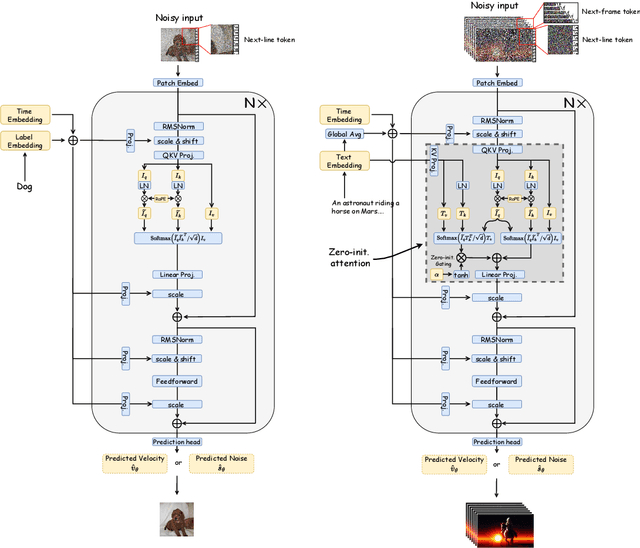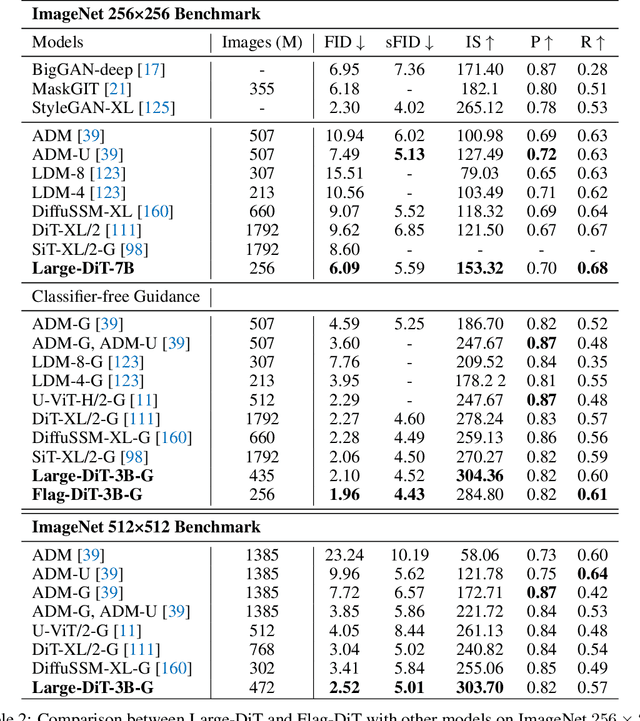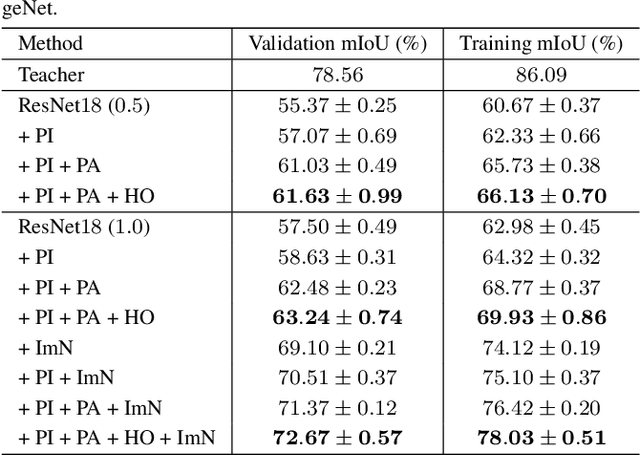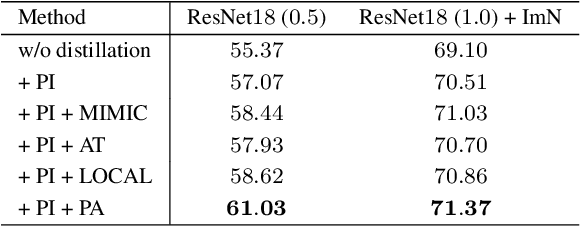Chris Liu
Lumina-T2X: Transforming Text into Any Modality, Resolution, and Duration via Flow-based Large Diffusion Transformers
May 09, 2024



Abstract:Sora unveils the potential of scaling Diffusion Transformer for generating photorealistic images and videos at arbitrary resolutions, aspect ratios, and durations, yet it still lacks sufficient implementation details. In this technical report, we introduce the Lumina-T2X family - a series of Flow-based Large Diffusion Transformers (Flag-DiT) equipped with zero-initialized attention, as a unified framework designed to transform noise into images, videos, multi-view 3D objects, and audio clips conditioned on text instructions. By tokenizing the latent spatial-temporal space and incorporating learnable placeholders such as [nextline] and [nextframe] tokens, Lumina-T2X seamlessly unifies the representations of different modalities across various spatial-temporal resolutions. This unified approach enables training within a single framework for different modalities and allows for flexible generation of multimodal data at any resolution, aspect ratio, and length during inference. Advanced techniques like RoPE, RMSNorm, and flow matching enhance the stability, flexibility, and scalability of Flag-DiT, enabling models of Lumina-T2X to scale up to 7 billion parameters and extend the context window to 128K tokens. This is particularly beneficial for creating ultra-high-definition images with our Lumina-T2I model and long 720p videos with our Lumina-T2V model. Remarkably, Lumina-T2I, powered by a 5-billion-parameter Flag-DiT, requires only 35% of the training computational costs of a 600-million-parameter naive DiT. Our further comprehensive analysis underscores Lumina-T2X's preliminary capability in resolution extrapolation, high-resolution editing, generating consistent 3D views, and synthesizing videos with seamless transitions. We expect that the open-sourcing of Lumina-T2X will further foster creativity, transparency, and diversity in the generative AI community.
SPHINX-X: Scaling Data and Parameters for a Family of Multi-modal Large Language Models
Feb 08, 2024Abstract:We propose SPHINX-X, an extensive Multimodality Large Language Model (MLLM) series developed upon SPHINX. To improve the architecture and training efficiency, we modify the SPHINX framework by removing redundant visual encoders, bypassing fully-padded sub-images with skip tokens, and simplifying multi-stage training into a one-stage all-in-one paradigm. To fully unleash the potential of MLLMs, we assemble a comprehensive multi-domain and multimodal dataset covering publicly available resources in language, vision, and vision-language tasks. We further enrich this collection with our curated OCR intensive and Set-of-Mark datasets, extending the diversity and generality. By training over different base LLMs including TinyLlama1.1B, InternLM2-7B, LLaMA2-13B, and Mixtral8x7B, we obtain a spectrum of MLLMs that vary in parameter size and multilingual capabilities. Comprehensive benchmarking reveals a strong correlation between the multi-modal performance with the data and parameter scales. Code and models are released at https://github.com/Alpha-VLLM/LLaMA2-Accessory
SPHINX: The Joint Mixing of Weights, Tasks, and Visual Embeddings for Multi-modal Large Language Models
Nov 13, 2023Abstract:We present SPHINX, a versatile multi-modal large language model (MLLM) with a joint mixing of model weights, tuning tasks, and visual embeddings. First, for stronger vision-language alignment, we unfreeze the large language model (LLM) during pre-training, and introduce a weight mix strategy between LLMs trained by real-world and synthetic data. By directly integrating the weights from two domains, the mixed LLM can efficiently incorporate diverse semantics with favorable robustness. Then, to enable multi-purpose capabilities, we mix a variety of tasks for joint visual instruction tuning, and design task-specific instructions to avoid inter-task conflict. In addition to the basic visual question answering, we include more challenging tasks such as region-level understanding, caption grounding, document layout detection, and human pose estimation, contributing to mutual enhancement over different scenarios. Additionally, we propose to extract comprehensive visual embeddings from various network architectures, pre-training paradigms, and information granularity, providing language models with more robust image representations. Based on our proposed joint mixing, SPHINX exhibits superior multi-modal understanding capabilities on a wide range of applications. On top of this, we further propose an efficient strategy aiming to better capture fine-grained appearances of high-resolution images. With a mixing of different scales and high-resolution sub-images, SPHINX attains exceptional visual parsing and reasoning performance on existing evaluation benchmarks. We hope our work may cast a light on the exploration of joint mixing in future MLLM research. Code is released at https://github.com/Alpha-VLLM/LLaMA2-Accessory.
ImageBind-LLM: Multi-modality Instruction Tuning
Sep 11, 2023Abstract:We present ImageBind-LLM, a multi-modality instruction tuning method of large language models (LLMs) via ImageBind. Existing works mainly focus on language and image instruction tuning, different from which, our ImageBind-LLM can respond to multi-modality conditions, including audio, 3D point clouds, video, and their embedding-space arithmetic by only image-text alignment training. During training, we adopt a learnable bind network to align the embedding space between LLaMA and ImageBind's image encoder. Then, the image features transformed by the bind network are added to word tokens of all layers in LLaMA, which progressively injects visual instructions via an attention-free and zero-initialized gating mechanism. Aided by the joint embedding of ImageBind, the simple image-text training enables our model to exhibit superior multi-modality instruction-following capabilities. During inference, the multi-modality inputs are fed into the corresponding ImageBind encoders, and processed by a proposed visual cache model for further cross-modal embedding enhancement. The training-free cache model retrieves from three million image features extracted by ImageBind, which effectively mitigates the training-inference modality discrepancy. Notably, with our approach, ImageBind-LLM can respond to instructions of diverse modalities and demonstrate significant language generation quality. Code is released at https://github.com/OpenGVLab/LLaMA-Adapter.
Structured Knowledge Distillation for Semantic Segmentation
Mar 12, 2019



Abstract:In this paper, we investigate the knowledge distillation strategy for training small semantic segmentation networks by making use of large networks. We start from the straightforward scheme, pixel-wise distillation, which applies the distillation scheme adopted for image classification and performs knowledge distillation for each pixel separately. We further propose to distill the structured knowledge from large networks to small networks, which is motivated by that semantic segmentation is a structured prediction problem. We study two structured distillation schemes: (i) pair-wise distillation that distills the pairwise similarities, and (ii) holistic distillation that uses GAN to distill holistic knowledge. The effectiveness of our knowledge distillation approaches is demonstrated by extensive experiments on three scene parsing datasets: Cityscapes, Camvid and ADE20K.
 Add to Chrome
Add to Chrome Add to Firefox
Add to Firefox Add to Edge
Add to Edge